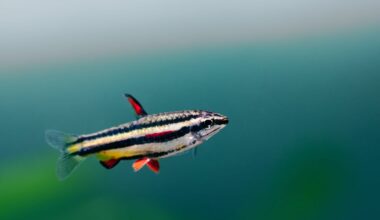There are so many types of small nano fish to keep in your freshwater aquarium that it can be hard to decide which is right for you.
Fortunately, this guide solves that problem!
In it, you’ll learn about each of the best fish for small tanks. All of the freshwater nano fish below are a joy to keep, and very convenient due to their size.
Simply look through this list, and pick your favorites!
1. Harlequin Rasbora
The Harlequin Rasbora is a tiny fish that’s a ton of fun to watch. They are endemic to blackwater bodies of water in Southeast Asia. Since these fish were discovered, they have been a popular commodity within the aquarist community.
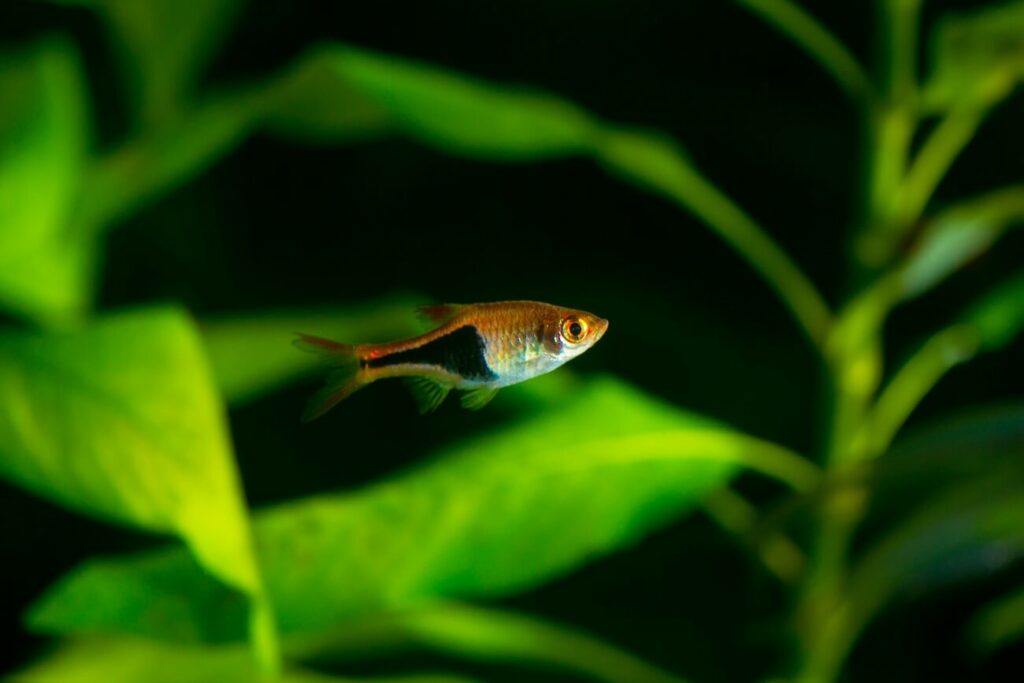
These are shoaling fish that prefer to stay in large groups. As a general rule of thumb, two fish can be kept for every gallon of water your tank can hold. At the very least, they should be kept in groups of six to ensure that they feel safe and confident in their surroundings.
These nano fish are named after their striking appearance. The body is covered in a pinkish-orange hue. However, the lower half of their body features a bold triangle-shaped patch of black. It looks like the pattern you would see on a medieval jester costume.
For the most part, Harlequin Rasboras are easy to take care of. As long as waters are around 74 degrees and have a pH of roughly 6.5, they should have no problem staying healthy.
- Size: 2 inches
- Difficulty: Beginner
- Minimum Tank Size: 10 gallons
2. Otocinclus
Also known as “dwarf suckers,” the Otocinclus is a great addition to nano tanks. Not only is this small catfish an interesting specimen to watch, but it will also play an important role in maintaining the ecosystem!
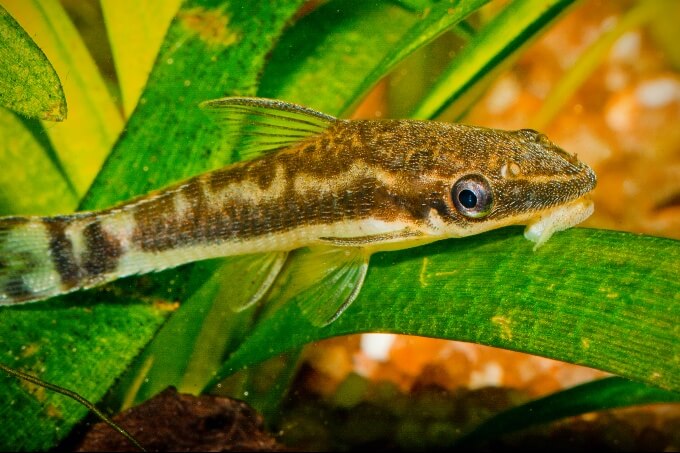
Otocinclus fish spend most of their time scavenging for algae. Like other suckerfish, they have expansive mouths that help them latch onto surfaces. You can often find them clinging onto the sides of your tank or hanging off of driftwood. Thanks to their small size, they can even latch onto large plant leaves.
Despite their penchant for algae, these fish do require some supplemental feeding. The Otocinclus is an herbivore. They do not eat meat-based snacks. However, they do enjoy blanched vegetables and algae wafers.
Otocinclus fish are very docile creatures. They prefer to stay in groups in and will often hide out in cave-like tank decorations whenever they’re not feeding.
- Size: 2 inches max
- Difficulty: Beginner
- Minimum Tank Size: 10 gallons
3. Least Killifish
This beginner-friendly fish is endemic to the southern United States. They can be found in fresh bodies of water throughout South Carolina and Louisiana.

Least Killifish are very shy creatures. Because of their small size, they are often the target of aquarium predators. As such, they are best kept in a single-species tank.
The good news is that you can keep several fish together. They thrive in small colonies. Throughout the day, you will witness all kinds of unique group behaviors.
The fish are known to shoal. This means that they stay in groups and spend a lot of time with each other. Sometimes, they will even school and swim in unison throughout your tank. It’s a unique sight to behold!
Another unique interesting thing about Least Killifish is that they are livebearers. This is a stark contrast to true Killifish, which lay eggs. Least Killifish are very easy to breed. Not only that, but adults can live with the fry without any issues.
- Size: 1.5 inches
- Difficulty: Beginner
- Minimum Tank Size: 5 gallons
4. Bumblebee Goby
The adorable Bumblebee Goby is a unique fish with some distinct looks. They are aptly named after the striking yellow and black stripes that cover their bodies. While they might be small, their coloration ensures that the fish are always seen.

Bumblebee Gobies are peaceful fish that prefer to stay at the bottom of the water column. They will claim an area and protect it fiercely. Luckily, most squabbles don’t result in any serious injuries.
These are brackish water fish. This means that they require a bit of marine salt in their ecosystem to truly thrive. A specific gravity level of approximately 1.002 to 1.006 is needed.
Freshwater Bumblee Gobies do exist, but they are far rarer than the traditional brackish variety. When you’re purchasing one of these fish, you need to make sure that you’re replicating the environment they were raised in to ensure that the fish stays healthy.
- Size: 1.5 inches
- Difficulty: Intermediate-Expert
- Minimum Tank Size: 10 gallons
5. Scarlet Badis
Scarlet Badis fish are some of the most popular freshwater fish for nano tanks. Take one look at them and it’s not hard to see why. These are beautiful fish!

The primary color of the Scarlet Badis is usually orange or red. Typically, a lighter shape is complemented by vertical stripes of a darker one. That’s not all, though! Bright neon blue accents can be found on the dorsal fins.
For the most part, Scarlet Badis fish are peaceful and non-aggressive. However, they are micro predators. That means they will hunt for insect larvae, tiny crustaceans, and any other source of protein they can find. You can keep your fish satisfied with a high-protein diet of live and frozen food.
Because of their predatory behavior towards smaller creatures, these are not the kind of freshwater nano fish you want to keep with shrimp! Despite their tiny size, Scarlet Badis are fully capable of hunting and eating ornamental shrimp.
- Size: 0.8 inches
- Difficulty: Beginner
- Minimum Tank Size: 10 gallons
6. Neon Tetra
There’s no doubt that you’ve seen Neon Tetras before. These pint-sized fish are immensely popular around the world and can be seen living happily in large tanks and neon tanks alike.

The Neon Tetra is named after its coloration. It features bold stripes of vibrant blue and red throughout its body. Males tend to be more vivid than females. But, all Neon Tetras are undeniably beautiful.
Playful by nature, Neon Tetras are a joy to watch. They do best in larger groups of fish, as they are a schooling species. When they group up, these fish create a swath of color that moves gracefully throughout your tank.
One big reason why these fish are so popular is that they are easy to care for. They’re unfussy and quite hardy compared to other species. Neon Tetras prefer temperatures in the range of 70 and 81 degrees. They also like a pH balance of 7.0 or less.
- Size: 1.5 inches
- Difficulty: Beginner
- Minimum Tank Size: 10-20 gallons
7. Betta Fish
The Betta fish has a bit of a sordid reputation. They are known to be aggressive. This behavior doesn’t just apply to other fish but also humans. Bettas will often show their colors and flair their gills at any onlookers enjoying their beauty!

Speaking of which, these nano fish are some of the most gorgeous around. There are several color variations out there. The Betta fish you see being sold in stores are most often males.
Male Bettas have long flowing fins that look like they are floating in the wind. Females are beautiful, too. However, they usually lack the vibrant colors and silk-like tales.
Bettas are very hardy and don’t require a ton of space to thrive. That’s why you see them being sold in small containers! However, that doesn’t mean that they can be kept in substandard tap water.
Like any other fish, they require a clean environment that’s continually maintained. Otherwise, the fish may experience disease like fin rot.
- Size: 3 inches
- Difficulty: Intermediate
- Minimum Tank Size: 5 to 10 gallons
8. Cardinal Tetra
Similar in appearance to Neon Tetras, the Cardinal Tetra is a separate species with its own care requirements. While they share the same blue and red coloration, some subtle differences in shape and pattern make these fish easy to distinguish from others.
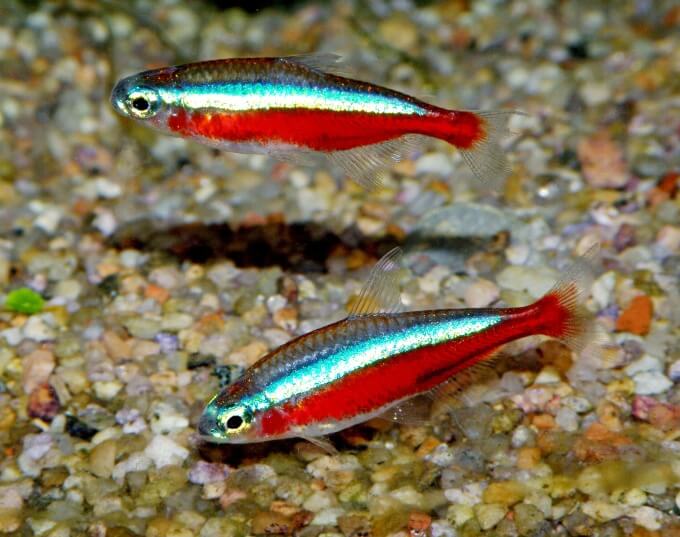
Originally found in South America, these nano aquarium fish prefer to stay in large groups. Like their Neon brethren, Cardinal Tetras are schooling fish that will often move around the tank as one. That said, they do enjoy their alone time every once in a while.
Cardinal Tetras do best in natural environments filled with organic hiding places. Floating plants, driftwood, and rock caves are all welcome.
These fish prefer warmer waters that are between 73 and 81 degrees Fahrenheit. They also like water that’s on the acidic side. They’ve been known to do well in water with a pH balance as low as 4.6. Though, most aquarists will hover around 6.0 for good measure.
- Size: 2 inches
- Difficulty: Beginner
- Minimum Tank Size: 15-20 gallons
9. Fancy Guppies
Guppies are another small fish with a visually striking appearance. These fish have long and flowing tails. Their caudal fins fan out quite a bit, creating a flash of color in your tank.

Like the Betta fish, Guppies come in a wide range of colors and patterns. You can find solid-colored specimens in bright colors like red, blue, or orange. However, most are going to have some type of striping or spotted pattern.
Fancy Guppies are very peaceful fish that prefer to stay towards the top of the water column. They’re not known for infighting. Though, their eye-catching colors do make them a target for predators.
These fish are very easy to breed. In fact, Fancy Guppies are known to breed without any intervention. As long as the water conditions are right and they have a safe place to spawn, they will do it!
Fancy Guppies are livebearers. The fry grows inside the female. When they are born they come out as fully-formed baby fish.
- Size: 2 inches
- Difficulty: Beginner
- Minimum Tank Size: 5-10 gallons
10. Asian Stone Catfish
Asian Stone Catfish are one of the smallest catfish species around. They make wonderful additions to nano tanks and will get along with most gentle fish species.
The body of the Asian Stone Catfish is very unique. They are masters of disguise thanks to their neutral body coloration. Splotches of brown, black, and gray create a beautiful texturized look. They blend in very well among rocks and debris, hence their name.
These catfish aren’t particularly demanding. They do just fine in standard home aquarium conditions. Though, they do require good oxygenation to stay healthy. So, you may want to invest in an air bubbler to keep them happy.
These are nocturnal fish that will spend most of the day in hiding. Once the lights go out, they become incredibly active and will spend their time searching for food. They can snack on algae, but they do best with live or frozen food.
- Size: 1.5 inches
- Difficulty: Beginner-Intermediate
- Minimum Tank Size: 10 gallons
11. Chili Rasbora
Also known as Mosquito Rasbora, the Chili Rasbora is a colorful addition and one of the best fish for small tanks. They are covered in shades of pink and red, making them stand out against a natural backdrop. Typically, the base color is complemented by a contrasting black stripe.

Despite their attention-attracting looks, these fish can be quite timid. When they’re first introduced to a new environment, they are known to spend their time in hiding. Though, this behavior subsides as they get comfortable.
The best way to make your fish feel confident in their surroundings is to keep them in a group. Chili Rasboras are schooling fish that will spend their days together. Oftentimes, the fish will swim in one fluid motion, putting on a nice show for any onlookers.
You can provide Chili Rasboras with commercial dried food as their main diet staple. However, they are micro predators in the wild. Thus, they love protein! Brine shrimp, Daphnia, and tubifex micro worms can keep them healthy and happy.
- Size: 0.7 inches
- Difficulty: Beginner
- Minimum Tank Size: 5-10 gallons
12. Rummy Nose Tetra
Originating from the Amazon River Basin, Rummy Nose Tetras are a good choice for nano tanks. Not only are they small, but they have some standout looks, too.
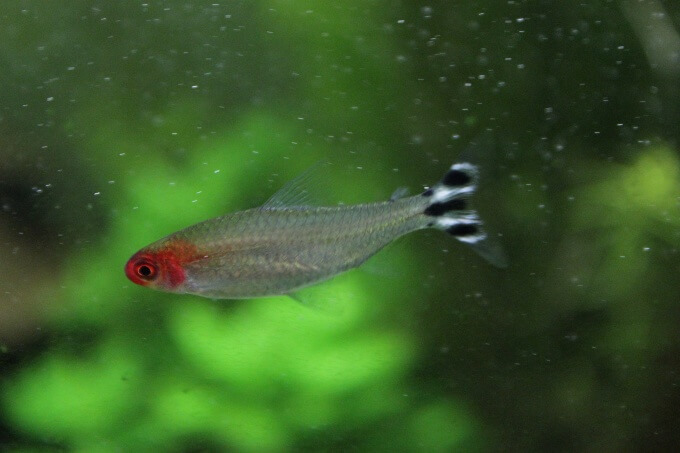
These fish are appropriately named after their vividly colored heads. Most of the body is transparent, allowing you to see individual bones. However, the head is covered in a fiery red hue.
The tail has some unique details as well. It features black and white stripes. This mismatch of patterns creates a very quirky look!
Like many popular tetra species, the Rummy Nose is a passive creature that does best in groups. Generally, these nano fish occupy the middle of the water column. They can swim to the top periodically for feeding, but they feel safest in the middle.
Speaking of feeding, Rummy Nose Tetras are omnivores that will eat anything they can find. You can often see them chowing down on plan detritus between meals.
- Size: 2.5 inches
- Difficulty: Beginner
- Minimum Tank Size: 20 gallons
13. Peacock Gudgeon
The Peacock Gudgeon is native to waters in Papua New Guinea, New Zealand, and Australia. These fish have a similar profile to freshwater gobies. As a result, they’re often misidentified. Peacock Gudgeons actually belong to a completely different genus.

These fish have slender bodies and rounded heads. The dorsal and anal fin is elongated, creating an interesting silhouette that stands out. When it comes to color, the Peacock Gudgeon is very vibrant.
Coloration varies, but most feature an iridescent blue base color that’s covered in bright red stripes. On the tale, these fish have a prominent black spot. Against the shape of their caudal fin, it looks like a peacock’s feature.
Peacock Gudgeons are peaceful fish that are happiest in a group. While they are generally easy to care for, these fish can be quite picky when it comes to food.
They prefer live or frozen food. Protein-rich foods like brine shrimp or bloodworms are a must.
- Size: 3 inches
- Difficulty: Beginner-Intermediate
- Minimum Tank Size: 15 gallons
14. Apistogramma
Apistogrammas are fish that break away from the conventions that most aquarists follow. Also known as the Dwarf Cichlid, these beautiful freshwater fish are part of the Cichlidae family! However, they don’t have the temperament of their larger relatives.

These are small peaceful fish that get along with most non-aggressive species. They do very well in groups and can cohabitate environments with fish that occupy the upper part of the tank. Most of the time, Apistogramma fish will spend their time close to the substrate.
From an appearance standpoint, these are fish are absolute stunners. There are several color variations available. You might see some fish covered in shades of blue, yellow, and red. Other times, you might see specimens with mohawk-like dorsal fins!
While many refer to the Apistogramma as a single species, there are actually more than 90 distinct varieties. There are even newly discovered Apistogramma fish that are still being evaluated by the scientific community.
- Size: 3 inches
- Difficulty: Beginner-Intermediate
- Minimum Tank Size: 20-30 gallons
15. Endler’s Livebearer
For many years, the Endler’s Livebearer was just though to be a color variant of the standard Guppy. Some in the aquarist community still view them as part of the Guppy family. However, these are a unique species in their own right.

They feature a similar profile to Guppies and take on the same bright coloration. Exact color patterns can vary dramatically, but you can often see splotches of fluorescent color covering their bodies. Like most species, males are more vibrant than females.
As you can guess from the name, these fish are livebearers. They are quite easy to breed and will often start pairing off without any invention from owners. This is a good thing, as the wild strain of the Endler’s Livebearer is thought to be extinct.
These are peaceful fish that occupy the top of the water column. They do well in groups and can thrive in community environments.
- Size: 1-2 inches
- Difficulty: Beginner
- Minimum Tank Size: 10 gallons
16. Zebra Danio
The Zebra Danio is a colorful freshwater fish species that does very well in nano tanks. They have the same iconic Danio profile. However, these fish are covered in relatively neutral tones compared to other species.
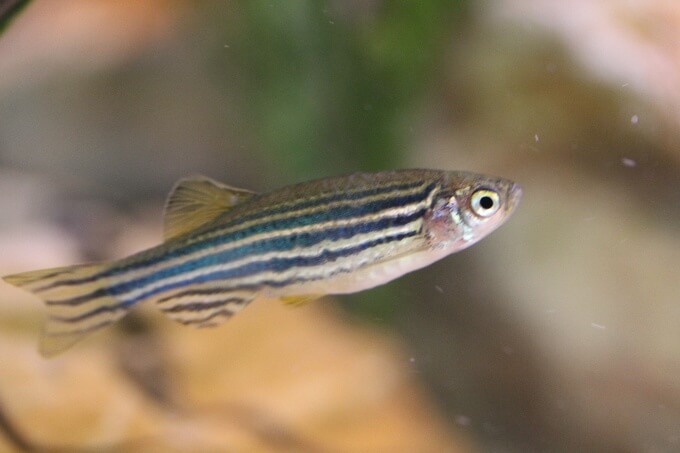
That said, the fish don’t look boring at all. As their name would suggest, Zebra Danios are covered in black and white stripes. The stripes run horizontally, creating a cool effect when they’re dashing throughout the tank.
Zebra Danios need to be in large groups. They have been known to live relatively short lives when kept alone. These are highly social fish that shoal and swim together.
They exhibit a unique social hierarchy. Some fish will exert dominance on others to maintain the pecking order. However, this behavior is largely playful and rarely results in injury.
Typically, Zebra Danios will stay in the middle of the water column. That said, they have been known to get hyperactive and take up the entire tank if kept in very large groups.
- Size: 2.5 inches
- Difficulty: Beginner
- Minimum Tank Size: 15 gallons
17. White Cloud Mountain Minnow
White Cloud Mountain Minnows are endemic to mountainous regions of China and Vietnam. They are a popular nano fish in the aquarist community and are often considered to be a more affordable alternative to Neon Tetras!

These fish do look strikingly similar to Neon Tetras. They have a prominent bright-blue strike running horizontally along the body. However, they lack the defined red stripe that Neon Tetras have. Instead, the red coloration is spread throughout the tail and fins.
White Cloud Mountain Minnows are excellent fish for beginners. They’re not particularly demanding. That said, they do require some specific water parameters to stay healthy. These fish prefer water that’s on the cooler side. It should be about 60 degrees Fahrenheit with a pH between 6.0 and 8.0.
Like other small fish species. White Cloud Mountain Minnows do best in groups of at least six. They’re very social and playful creatures that need some company to truly thrive.
- Size: 2 inches
- Difficulty: Beginner
- Minimum Tank Size: 10 gallons
18. Celestial Pearl Danio
Celestial Pearl Danios are another fish that’s easy to care for. In the wild, these fish live in shallow rivers and ponds that are filled with plants. It’s the perfect environment to replicate in your nano tank.
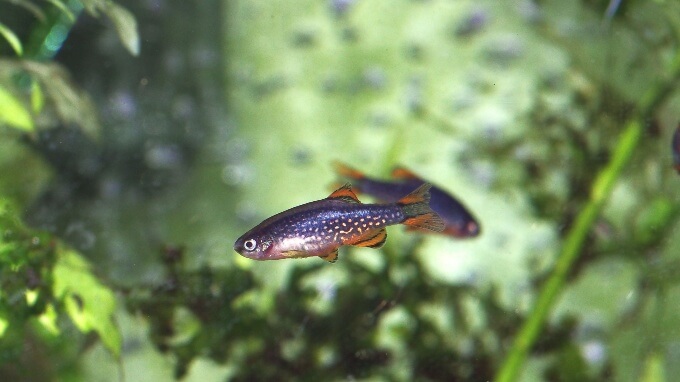
These fish prefer dense vegetation and warm waters. They do best in temperatures between 73 and 79 degrees. The pH balance should be relatively neutral as well.
Like other Danios, Celestrial Pearls have rounded bodies and big beady eyes. They get their name from the galaxy-like pattern on their body. The primary color of the fish is black. But, that’s broken up with several small white spots.
You may also see some red coloration around the fins and belly. Some specimens even have striped fins.
While they are not true shoaling fish, Celestial Pearl Danios do like to be kept in groups. They are usually non-aggressive. However, males are known to fight over females pretty regularly. It can get ugly, so try to keep the male population to a minimum.
- Size: 1 inch
- Difficulty: Intermediate
- Minimum Tank Size: 10 gallons
19. Bluefin Notho
Next up, we have the Bluefin Notho. Also known as a Rachovi Killifish, these fish are vibrant and full of life. Unfortunately, the life expectancy of this fish usually isn’t very long.

These are annual fish that are found in marshes throughout Africa. They are considered annual fish because they appear during the rainy season. Most wild specimen will complete their lifecycle in only a year. They have been known to live up to two years in captivity.
These are brightly colored fish. Males are covered in bright red, neon blue, and black. Females are more subdued, taking on a silver hue with some slight iridescent shimmer.
Bluefin Nothos are peaceful creatures that live life fast! They reach maturity fairly quickly and are easy to breed. These fish have some unique breeding patterns, which are interesting to watch. They often bury eggs in substate to keep them protected as they mature.
- Size: 2.5 inches
- Difficulty: Intermediate
- Minimum Tank Size: 5-10 gallons
20. Sparkling Gourami
Here’s another fish for small tanks that you’ve probably seen before. They are sold by big-name pet stores and small shops alike! It’s not hard to see why. These are gently fish that aquarists love.
One of the biggest reasons why people love these fish so much is their looks. Sparkling Gouramis look like a shell floating through the water. Their body is covered in a stunning pattern.
Typically, males will have patches of bright red or brown. This is complemented by a series of bright blue dots that take on an iridescent shimmer.
Sparkling Gouramis are very peaceful by nature. They’re not looking for trouble and will be happy enough just exploring the tank. These fish frequently visit the surface of the water to get some air, which is a quirky behavior that not a lot of fish species have.
- Size: 1.5 inches
- Difficulty: Beginner-Intermediate
- Minimum Tank Size: 15 gallons
21. Pygmy Corydoras
Pygmy Corydoras are a funny-looking fish that gets along with most tank mates. They tend to stick to themselves. Most times, these fish will stay towards the bottom of the tank. You can usually find them hidden among plant debris and driftwood.

They do like to stay in groups and exhibit shoaling behavior pretty frequently. However, rather than swimming and exploring, a lot of that group time is spent scavenging for food!
Contrary to popular belief, these fish are not like traditional algae eaters. They may chow down on plant detritus from time to time, but they much prefer protein-based snacks. They enjoy bloodworms, insect larvae, and brine shrimp.
Pygmy Corydoras have a very distinct look. They have large bulbous bodies. It’s usually covered in metallic silver brown colors. A prominent black stripe runs the length of the body. Towards their head, you’ll see a tiny set of barbels that the fish use to navigate the tank.
- Size: 1-1.5 inches
- Difficulty: Beginner
- Minimum Tank Size: 10 gallons
Which Ones Do You Like Most?
Now that you about each of the best freshwater fish for small tanks, you should pick your favorites. There are probably a few that caught your eye already, so go back and wrote those down!
We’ve been huge fans of keeping nano fish in our aquariums for years now. There’s something about seeing these small colorful creatures move around that’s addicting to watch.
If you’re still unsure and want a little help deciding, we’re more than happy to talk with you. We have experience with each of the species on this list so we can definitely give you the extra info you need!

